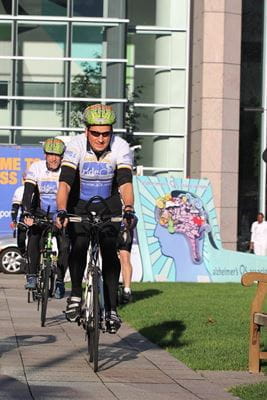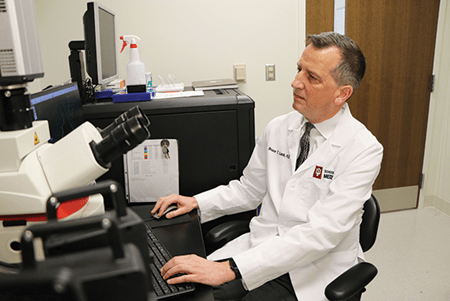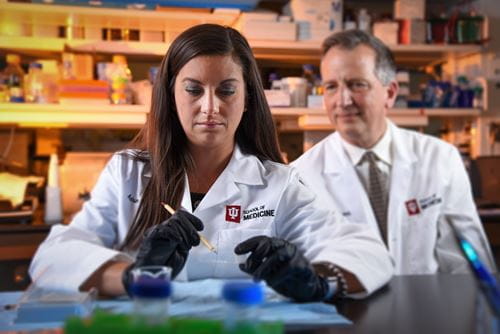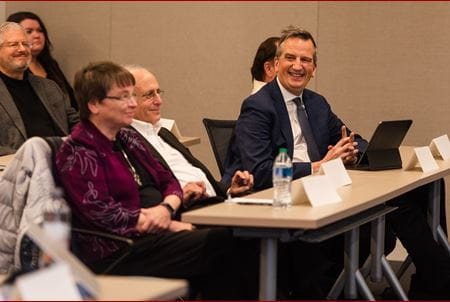Despite being a nationally recognized research scientist in Alzheimer’s disease and the executive director of the Stark Neurosciences Research Institute at Indiana University School of Medicine, Bruce Lamb, PhD, has no formal training in neuroscience.
“I actually taught myself neuroscience,” said Lamb, who recently was named an Indiana University Distinguished Professor, the university’s highest academic title. He will share his career journey at the Distinguished Professor Symposium on April 11, 2023, at IU Bloomington.
“Neuroscience was really not on my radar until I did my postdoctoral fellowship at Johns Hopkins,” explained Lamb, who holds a PhD in molecular biology from the University of Pennsylvania.
At Johns Hopkins, Lamb worked under John D. Gearhart, PhD, a pioneer in stem cell research. At the time, Gearhart was studying Down syndrome, and Lamb became fascinated with the connection between this chromosomal disorder and a significantly elevated risk for developing Alzheimer’s disease in adulthood.
“As a postdoc, I generated a mouse model for Down syndrome and Alzheimer’s disease using new technologies we had developed at that time,” said Lamb, who went on to work as a neuroscientist at Cleveland Clinic’s Lerner Research Institute following his first faculty position at Case Western Reserve University. “I always tell my graduate students that I’ve had no didactic training in neuroscience, so sometimes you’re going to enter a field and have to figure it out—learn things you didn’t know you would need to learn.”
Today, Lamb leads the Stark Neurosciences Research Institute, co-directs the IU School of Medicine-IU Health Neuroscience Institute and is the Roberts Family Professor of Alzheimer’s Disease Research at IU School of Medicine. At Stark, he oversees a team of more than 100 faculty investigators with a collective $75 million in funding from the National Institutes of Health (NIH), working in nine research interest groups—addiction, neurodegenerative disorders, neurodevelopment, neuroimaging, ocular neurobiology, pain, psychiatric disorders, spinal cord and brain injury, and stem cell research.
 Lamb is the principal investigator on IU School of Medicine’s top federally funded research program, Model Organism Development and Evaluation for Late-Onset Alzheimer’s Disease (MODEL-AD), which brought in $9.8 million from the NIH in 2022 and will bring a total of $48.8 million over the next five years. In the No. 2 spot is the Alzheimer’s Disease Drug Discovery Center (also known as TREAT-AD), another research initiative Lamb works on with Principal Investigator Alan Palkowitz, PhD. It’s a partnership with Purdue University aimed at discovering new therapeutic targets and developing new drugs to slow disease progression.
Lamb is the principal investigator on IU School of Medicine’s top federally funded research program, Model Organism Development and Evaluation for Late-Onset Alzheimer’s Disease (MODEL-AD), which brought in $9.8 million from the NIH in 2022 and will bring a total of $48.8 million over the next five years. In the No. 2 spot is the Alzheimer’s Disease Drug Discovery Center (also known as TREAT-AD), another research initiative Lamb works on with Principal Investigator Alan Palkowitz, PhD. It’s a partnership with Purdue University aimed at discovering new therapeutic targets and developing new drugs to slow disease progression.
“Bruce has created a far-reaching program that is bringing new understanding to the scientific community and putting tools in the hands of top researchers to accelerate knowledge growth in the field that, hopefully, we can use to create new drugs and therapies,” Palkowitz said.
Cycling for funding
 It wasn’t always so easy to get federal funding for Alzheimer’s disease research. Back in 2010, just 6 percent of grant proposals in the field were funded.
It wasn’t always so easy to get federal funding for Alzheimer’s disease research. Back in 2010, just 6 percent of grant proposals in the field were funded.
“I was feeling distraught, given what an important area of research I thought it was,” Lamb said.
He and a colleague at the Alzheimer’s Association, Maria Carrillo, PhD, hatched an idea to increase awareness. They recruited 60 Alzheimer’s researchers from across the country to participate in a relay-style bicycle ride spanning 4,500 miles from San Francisco to Capitol Hill. Along the way, they collected 110,000 signatures from Americans who wanted to see more research funding for Alzheimer’s.
“In small towns across the USA, people would see this gigantic purple van that followed us and come out of their houses to see what was going on,” Lamb said. “We would start talking to people, and everybody had a story—a parent, sibling, grandfather, friend—someone who was affected by this disease.”
Lamb biked about 600 miles of the relay including sections in California, the high desert of Arizona and New Mexico, Michigan, Pittsburgh, and the home stretch to Washington, DC. In Ann Arbor, Michigan, he was joined by Charlie Farrell, MD, a retired vascular surgeon and multisport athlete who was the primary caregiver for his wife, a scientist “slipping into the fog of dementia,” as Farrell expressed it in a blog for the Alzheimer’s Association.
 While Lamb can’t take full credit, federal funding for Alzheimer’s research has increased eightfold since the summer of 2010 Alzheimer’s Breakthrough Ride. In January 2011, the National Alzheimer’s Project Act was signed into law, leading to the creation of a national strategic plan to accelerate research and improve care for people living with Alzheimer’s and related dementias.
While Lamb can’t take full credit, federal funding for Alzheimer’s research has increased eightfold since the summer of 2010 Alzheimer’s Breakthrough Ride. In January 2011, the National Alzheimer’s Project Act was signed into law, leading to the creation of a national strategic plan to accelerate research and improve care for people living with Alzheimer’s and related dementias.
For most of his career studying the genetics and pathology of Alzheimer’s, Lamb had no personal connection to the disease. But now his father-in-law has moderate-stage Alzheimer’s, and his mother is experiencing mild cognitive impairment, a likely precursor to Alzheimer’s disease. Lamb and his wife moved her parents into their home last fall to help with caregiving.
“It’s much more personal now,” he said. “We live it every day.”
Recruiting top researchers
According to the Alzheimer’s Association, about 6.7 million Americans live with this disease, including about one in nine people age 65 and older. Almost two-thirds are women, and Black Americans are about twice as likely to develop Alzheimer’s as white Americans.
 By 2050, the number of people living with Alzheimer’s is projected to be about 13 million unless medical breakthroughs can prevent or cure this degenerative cognitive disease.
By 2050, the number of people living with Alzheimer’s is projected to be about 13 million unless medical breakthroughs can prevent or cure this degenerative cognitive disease.
“I’m pretty sure part of the solution will come from IU,” said Lamb, who was recruited to IU School of Medicine from the Cleveland Clinic in 2016 to lead the Stark Neurosciences Research Institute.
Since his arrival, Lamb has been actively involved in recruiting 15 new faculty with expertise in various areas of neuroscience. IU currently ranks No. 4 on the list of institutions receiving the most funding from the NIH’s National Institute on Aging and has become one of the nation’s leading resources supporting Alzheimer’s research throughout the United States.
Lamb serves on the Alzheimer’s Association Board of Directors and chairs the organization’s Medical and Scientific Advisory Group, while also serving on the Indiana chapter board.
“Bruce brings a tremendous network within the scientific community that is working on different aspects of piecing together this very complex picture of Alzheimer’s disease,” Palkowitz said.
 Under Lamb’s leadership, IU School of Medicine is bringing in top talent, investing in new technologies and capitalizing on grant opportunities, added Palkowitz.
Under Lamb’s leadership, IU School of Medicine is bringing in top talent, investing in new technologies and capitalizing on grant opportunities, added Palkowitz.
“Bruce is one of those unique individuals who can move between the basic science and the higher strategic picture pretty fluidly,” Palkowitz said. “He understands how all these little pieces potentially fit together to not only create a broader view of the disease but also translate that into research programs and other activities to really advance the field. That’s a unique skillset, and one that’s honed over years of being an excellent student and observer. He’s also a great colleague and mentor.”
Staying humble and thinking big
Lamb developed an interest in using the mouse as a model system for studying biological mechanisms of disease while he was a PhD student at the University of Pennsylvania. The trajectory of his career was further shaped by his fellowship at Johns Hopkins, followed by his first faculty position at Case Western Reserve in Cleveland, Ohio, where he “just happened upon” one of the top genetics departments in the country, led by famed geneticist Huntington Willard, PhD.
 “When I think back on it now, the colleagues I had at that time were unbelievable,” Lamb said. “I watched how Hunt Willard handled things as a leader, and those things have stuck with me and certainly helped me as I took on new roles involving more leadership skills.”
“When I think back on it now, the colleagues I had at that time were unbelievable,” Lamb said. “I watched how Hunt Willard handled things as a leader, and those things have stuck with me and certainly helped me as I took on new roles involving more leadership skills.”
Lamb is now a key mentor to several colleagues in the field of Alzheimer’s.
“Dr. Lamb is an excellent communicator, listener and teacher,” said Adrian Oblak, PhD. “He provides the tools, guidance, support and feedback that junior faculty need to thrive in their academic career.”
Lamb hired Oblak in 2016 as center manager for MODEL-AD; she now serves as co-principal investigator for the grant, which was recently renewed for another five years.
“Before taking the position, I asked Dr. Lamb what the possible growth opportunities were,” Oblak recalled. “He told me that he thought growth was well beyond anything we could currently consider. He was right. We currently have the second-largest grant awarded to IU and have plans for a larger, collaborative project.”
Oblak said she admires Lamb’s positivity.
 “Dr. Lamb and I discuss regularly about what it is to be a great leader, and one of those qualities is to never say ‘no.’” she said. “Dr. Lamb is always willing to take on new challenges and only expects that the outcome will be positive.”
“Dr. Lamb and I discuss regularly about what it is to be a great leader, and one of those qualities is to never say ‘no.’” she said. “Dr. Lamb is always willing to take on new challenges and only expects that the outcome will be positive.”
While Lamb is a visionary leader, he’s also humble.
“Alzheimer’s is one of those areas where, if you’re not humbled by the science, you’re probably not the right person to work in the field,” Palkowitz said. “Bruce understands and appreciates the magnitude of the challenge of Alzheimer’s.”
Lamb is keenly aware that solutions will come through teamwork.
“Bruce is very inclusive and creates opportunities for others,” Palkowitz said. “That humility goes into building the right kind of culture to take on that level of complexity and build teams and partnerships that can really have an impact. He’s a great facilitator.”
